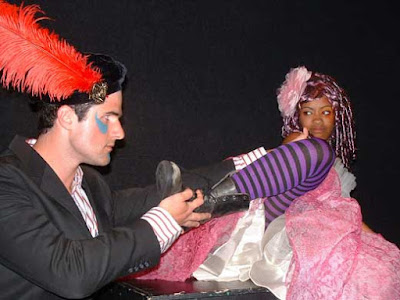"The Santaland Diaries"
Theatre review
"The Santaland Diaries" at Syracuse Stage
Ithaca Times
December 17, 2008
706 words
"Ho Ho Help"
full text here
Ho Ho HelpMark Tedeschi
The Santaland Diaries by David Sedaris, adapted for the stage by Joe Mantello. Directed by Wendy Knox. Starring Wade McCollum. With scenic and costume designer Jessica Ford, lighting designer Alex Koziara, and sound designer Sarah Pickett.
There's a one-actor play at Syracuse Stage called The Santaland Diaries that's about an hour and fifteen minutes long, roughly the same amount of time it takes for a drive to the theater from Ithaca, one way. If you're a diehard David Sedaris fan, though, or just in the mood for some top-notch seasonal comedy, this show is well worth the trip.
Santaland is based on the essay that, when Sedaris read it on NPR's "Morning Edition" in 1992, sparked literary attention for his shrewd, irreverent style. Four years later, Tony Award-winning director Joe Mantello adapted Sedaris's "Santaland Diaries" for the stage, placing much of the original text verbatim into the show and adding his own equally punchy portions of elaborations and side-stories.
At Syracuse's Storch Theatre, Jessica Ford's set extends into the hallways, successfully disguised as cheery Christmas decorations under the customary call of bubbly holiday staples like "Feliz Navidad." As Wade McCollum, the lone performer in Santaland, launches his narration, the pine-green wreaths, shiny ornaments, and ribbon-tied presents adorning the edges of the stage begin to conjure the all-too-familiar but annually tolerated stresses of the season. Santaland is a true account of Sedaris's starving-artist decision to apply for a job as an elf in Macy's Santaland and the borderline insane encounters he has with flirtatious co-elves, a sundry spectrum of Santas, and exasperated parents.
McCollum's character gives himself the elf name "Crumpet" (one of those inherently funny words - later, he changes it to "Blisters") and vividly describes both the elf outfit he must wear (Ford designed that too) and the surreal environment in which he is to wear it. Luckily, this is a theatre performance, not an essay reading; we actually get to see both. He changes into candy cane leggings, a yellow turtleneck, a green vest, a green hat, and oversized green shoes. After dressing, stone-faced, he expertly delivers the classic Sedaris line, "This is my work uniform."
When the curtain goes up, surprise! Santa's illustrious chair sits in front while snowdrift-covered trees and houses recede deep into the Santaland background.
McCollum, under Wendy Knox's direction, confidently pitches Sedaris's rapid-fire language from deadpan mentions of "parents relentless on their quest for documentation" to lurid fantasies of Santaland's transformation into a kind of hellish Satan-land. The latter is a prime example of McCollum's performance cooperating with the lighting (Alex Koziara) and sound (Sarah Pickett): the entire stage bathed in crimson, a low rumble emanates from the speakers as McCollum envisions the "pools of blood and feces" the visitors must wade through.
Gross, huh? Sedaris's humor isn't typically for young children, and this is no exception. His jokes are often harsh and sometimes risky enough to miss their target from time to time, but the joke density in a Sedaris piece is thick enough to move smoothly from one to the next without breaking momentum. Crumpet's observations on the folks who ask for their child to specifically see either a black or a white Santa could fall flat, but the ruminations' objectivity enhances their comedy.
Other imitations of Santaland visitors occur at regular intervals; McCollum proves a knack for giving each a distinct flair. A jokester dad from Jersey provides his best fodder, while his occasional crowd-milking mugging as in a dimwitted waitress ranks among the weaker moments. The consistent discovery natural to Sedaris's dependable style shows up on the stage; lighting tricks like a bright flash indicating a kid-with-Santa photograph or a falling-snowflake effect are saved for the second half of the show.
Four days to Christmas, the holiday stresses escalate. Crumpet begins to snap back at disgruntled guests who whine, "I'm gonna have you fired!" with, "I'm gonna have you killed!" Closer to the day, Mantello dives into a heartfelt but nonetheless cornballish departure from straight comedy in favor of a sobering reminder of the "It's Christmas" spirit of selflessness we see in countless holiday stories from Miracle on 34th Street to Bad Santa.
The segue, different from the comparatively cynical ending of the source material, is unexpected - but not unwelcome. Sedaris is the first to include himself in his fault-finding; but when the unstoppable force of his societal criticism meets the immovable object of holiday atmosphere, even self-deprecation can take a breather.

Wade McCollum in ‘The Santaland Diaries,’ now at Syracuse Stage. (Photo by T. Charles Erickson)
Labels: ithaca times, review, syracuse, theatre review









